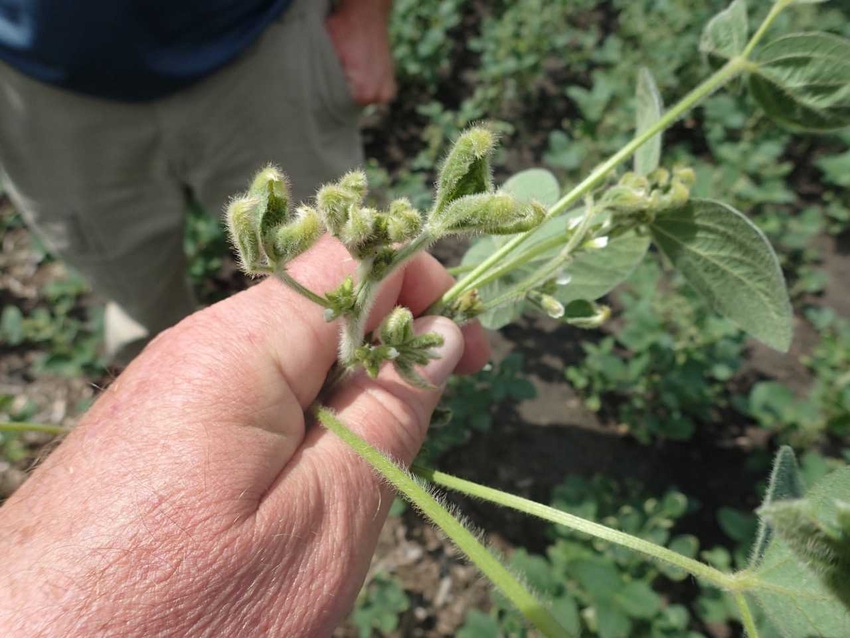May 25, 2018

By Andrew A. Thostenson, North Dakota State University Pesticide Program Specialist
Source: North Dakota State University
Collectively, agriculturalists across the major soybean and cotton growing states are hoping for a much more successful year compared to 2017. No matter how you slice it, 2018 will not and cannot be a repeat of 2017.
Area
—In parts of the Mid-South, 60% or more of the available soybean and cotton acres could be planted to dicamba tolerant varieties. As you move farther North, that percentage declines modestly, but even in the Dakota’s, farmers are expected to plant nearly half of the projected soybean acres to DT strains. That means more dicamba will be used, perhaps twice as much as 2017. In some areas where difficult to control, glyphosate resistant weed pressure is severe, we could see much more (two applications per field). On the other hand, some have suggested that a significant number of farmers may plant the new traits for defensive purposes and NOT spray dicamba. While this may be the intention in May, it is unlikely they will leave a tool that they have already paid for in the tool box, especially in June or July when an unexpected weed flush appears.
Arkansas, Michigan, Wisconsin, Northern North Dakota, and Minnesota will be different in 2018. If Arkansas continues their in-season prohibition, it could theoretically reduce problems by about one third. On the other hand, far Northern areas will be using the technology for the first time in 2018. (Seed stock was not widely available last year.)
Weather
—Meteorologist Darrel Ritchison with NDSU has often said no two years are alike when it comes to the weather. That is undeniably true. One need only look at how cold the spring was throughout most of the mid-section of the U.S. We are two weeks or more behind last year in much of the country. In the Mid-South, they are just beginning to make post applications of dicamba to soybeans. In 2017, some of the earliest reports of off target movement did not surface until about May 20th in Arkansas. That will not be the case this year. Even if problems begin to surface in 2018, we will not see anything for another 14 to 21 days (from the time of this writing).
Regulatory landscape
—Obviously, big changes have been made on this front. The labels saw major revisions in October of 2017. Further, many states have enacted additional restrictions. An excellent summary, state by state can be found here: https://aapco.org/2015/07/02/dicamba. How these changes will or will not impact off-target movement in 2018 is anyone’s guess.
Training
—Will the massive and NEVER before applicator training program conducted over the winter and early spring result in significantly less problems in 2018? That too is up for debate. Some states refused to let registrants conduct the Auxin Training, while others demanded that they be wholly responsible. Still a few others offered university sponsored trainings AND registrant trainings. Regardless, all applicators who intend to use the technology in 2018, at a minimum, know fully what the label says. Whether they understand the label and whether that label can and will be followed also remains a question.
Some factors in 2017 will be the same in 2018:
1. Biological Activity--Dicamba, is active at almost the molecular level. 1/20,000 of the field rate is sufficient to illicit response in non-DT Soybeans. (Even lower doses and multiple low dose exposures are being evaluated.) Thus, ANY off-target movement can be harmful.
2. All Spray Applications Drift--There is no such thing as perfection or zero physical movement. You can minimize it, you can mitigate it, but you cannot get it to zero. This fact, plus biological activity means down-range sensitive plants will be at risk. That is why there are such exacting application requirements and buffers on the 2018 labels.
3. Decision Making--There will always be pressure to push the boundaries of the
label because of time and money. Couple that with varying degrees of label comprehension, and you will still have serious challenges to overcome.
4. Environment--Topography and weather place enormous limitations on applicators and they are the final arbiter of how much dicamba will move via physical drift. Combining 2 and 3 with exacting environmental constraints and the potential for problems remains significant.
5. Volatility—All dicamba formulations volatilize. Formulation changes were NOT made with the basic chemistry of these new products from 2017 to 2018. There is no consensus as to how much off-target movement of dicamba in 2017 originated through volatilization. EPA did not wade into this debate, other than to agree with registrants and land grant scientists that contamination of equipment with certain chemicals, like ammonium sulfate (AMS), can render the new formulations very volatile. Thus, strict hygiene protocols were introduced. Applicators have been warned repeatedly that a contaminated handling/spray system is TABOO. Regardless, applicators across the U.S. remain anxious at best about this factor.
No matter where you come down on the volatility debate, the first four points are daunting enough, and it remains to be seen if these concerns have been adequately addressed.
In summary, for sure, 2018 will not be like 2017. But only time will tell if it will be better, or worse. With the late planting/spray season, one should remain cautious and vigilant, even if early season complaints seem to be fewer than the unprecedented year that was 2017. As the Office of Indiana State Chemist has repeated for several months this training season, “Using this new technology is like threading a needle.” Best to put on your reading glasses if you are doing fine work - and don’t ignore a word on those labels.
Originally posted by North Dakota State University Extension.
You May Also Like




